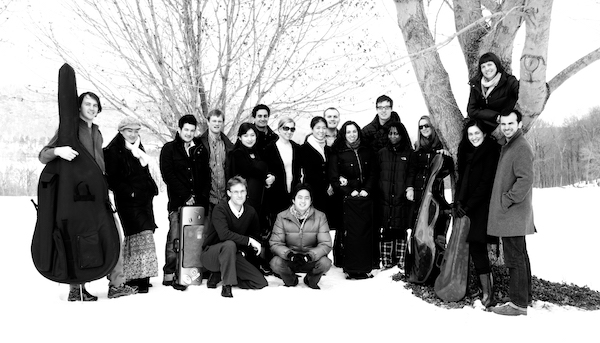East Coast Chamber Orchestra connects the hemispheres for Candlelight Concerts

The East Coast Chamber Orchestra performed Saturday night in Baltimore, presented by Candlelight Concert Society. Photo: Vanessa Briceño-Scherzer
The East Coast Chamber Orchestra paid a visit to the area on Saturday night. The ensemble played a concert of dance-inspired repertoire at the Earl and Darielle Linehan Concert Hall, which opened in 2014 on the campus of the University of Maryland, Baltimore County. The opportunity to hear the group in the pristine, warm acoustic of this relatively new venue came thanks to the Candlelight Concert Society.
ECCO is a conductor-less ensemble comprised of a flexible roster of top string players from around the country, some recognizable from other chamber music ensembles. They are a collective, listing the musicians in alphabetical order in the program and rotating stage formation and leadership with each piece. The sound they produced was rich, varied, and impressively unified in this program focused on early music and the cultural interchange of Europe and South America.
Several of the pieces were in the form of the chaconne, a set of variations over a repeating bass pattern. The chaconne likely came to Europe as a popular dance from South America, becoming a courtly dance and then a statelier instrumental form. This program opened with an English version, Purcell’s Chacony in G Minor, arranged for string ensemble by Benjamin Britten.
When the group explored the soft dynamic range, the sound was rarefied and intense. At the loud end, however, they tended to hammer attacks mercilessly, making a forte sound that bordered on unpleasant. A grand rallentando ended the piece, drawn out over almost the whole last statement of the ground bass, which seemed affected.
The music of Gabriela Lena Frank exemplified the trans-Atlantic nature of the program. An American with roots in Europe and Peru, she has drawn on her research of Peruvian folk music and traditions in pieces like Leyendas: An Andean Walkabout. In these six vignettes, she asks the string players to imitate the sounds of Peruvian folk instruments. The bending tone of the violas in the first movement recalled rustic panpipes, for example, and the second movement’s violin solo in rough-hewn double-stops evoked small, harsh flutes.
In this piece, ECCO’s more robust style proved an asset in the ferocious dances, col legno strikes, and percussive Bartók pizzicati. The fifth movement was the most memorable, layering keening wails into masses of dissonance, in alternation with paraphrases of the “Dies Irae” chant in ghostly harmonics. The sixth movement, in an easy pop-folk idiom, seemed an unnecessary afterthought.
Michi Wiancko’s eccentric arrangement of the Chaconne from Bach’s Violin Partita No. 2 reworked this celebrated piece with pizzicati, harmonics, and other effects. This performance was strongest in the middle section, which shifts to the major mode, given here to two cellos with viola and other strings gradually added. The arrangement made this serene, intimate solo work into an almost tango-like showpiece.
That South American connection was made explicit in a set of three Renaissance dances arranged by Maureen Nelson. In the simple outer movements, included one from Peru, a cellist added folksy rhythmic accents with bells attached to his stomping ankle. The middle piece, Josquin Desprez’s “Mille regretz,” is one of the great partsongs of music history, and the hushed strings sang it plangently.
From this high point of early music, the program came full circle with the “Chacony” movement of Britten’s String Quartet No. 2, composed in honor of the 250th anniversary of Purcell’s death. When played by string ensemble the music lost some of its pungent austerity, as the dissonant melodic pattern is ornamented in a score of often stark variations. The movement’s conclusion, in which a series of C major chords, growing in confidence, overcome that serpentine theme, became even more triumphant with the amassed strings over the double-bass foundation.
Pianist Christopher Shih joins the Escher Quartet 7 p.m. May 11 for music by Mozart, Korngold, and Dvořák. candlelightconcerts.org; 410-997-2324
